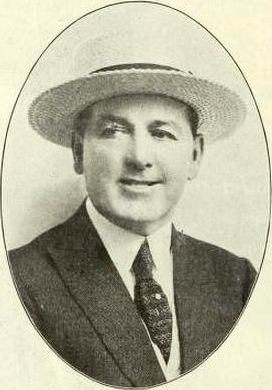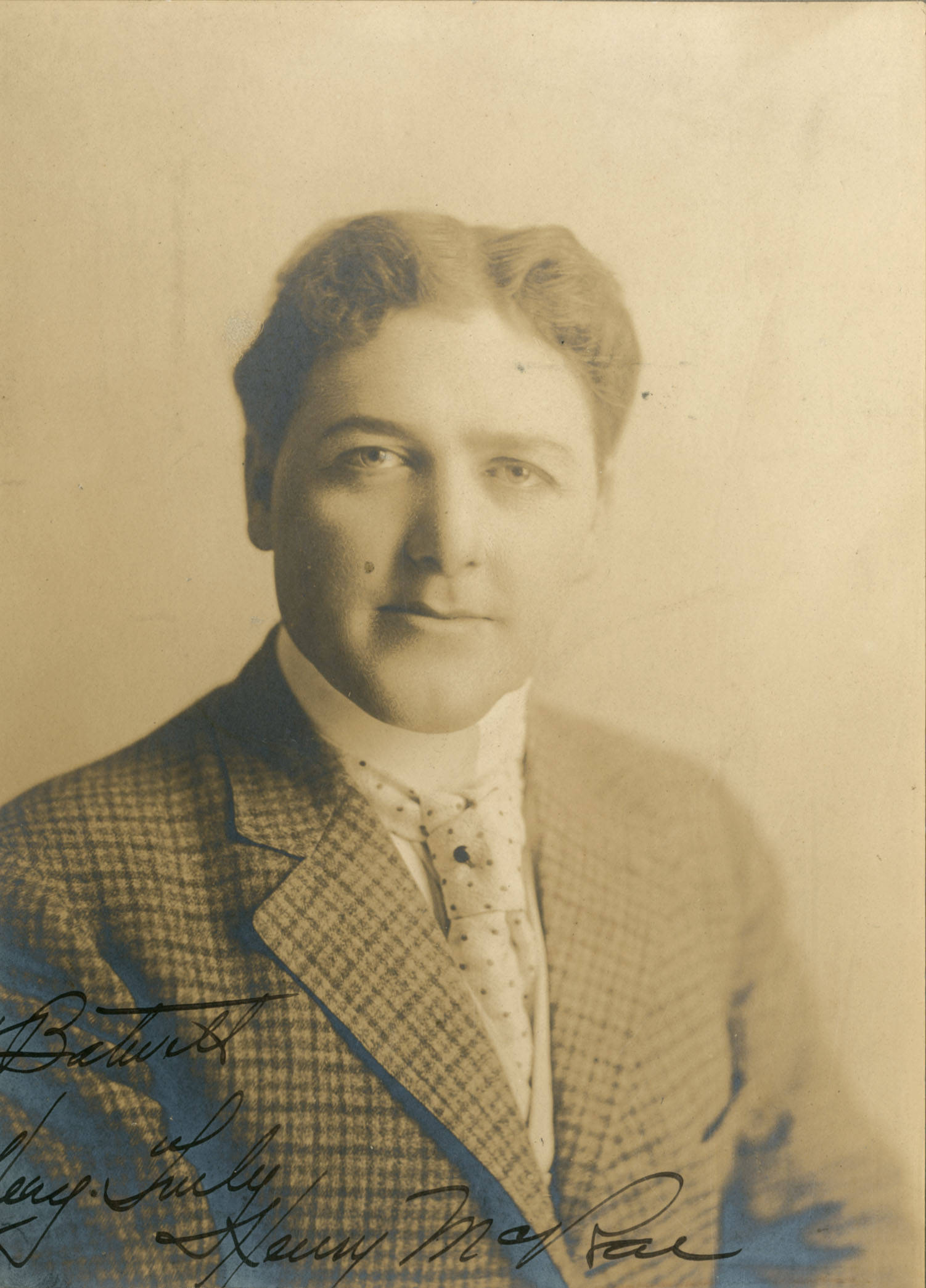1. Overview
Henry Alexander MacRae (August 29, 1876 - October 2, 1944) was a highly influential Canadian film director, producer, and screenwriter who made significant contributions to the silent film and early talkie eras of Hollywood. Recognized as one of the pioneering Canadian figures in early Hollywood, MacRae was a prolific filmmaker, directing over 130 films, primarily serials, for Universal Studios. His enduring legacy is marked by his groundbreaking innovations in film production techniques, which included the pioneering use of artificial light for interiors, wind machines, double exposures, and the practice of shooting at night. These advancements significantly shaped the technical evolution of cinema, establishing him as a crucial figure in the development of modern filmmaking practices.
2. Early Life and Background
Henry Alexander MacRae's early life and entry into the burgeoning film industry set the foundation for his extensive and impactful career as a director, producer, and screenwriter.
2.1. Birth and Early Life
Henry Alexander MacRae was born on August 29, 1876, in Toronto, Ontario, Canada. He later relocated to the United States, where his career in the film industry began.
2.2. Entry into the Film Industry
MacRae commenced his career in the film industry in 1912, beginning his directing work with Selig Polyscope Company, where he directed his first known short film, A Heart in Rags. Later that same year, he transitioned to Bison Motion Pictures, a company whose films were distributed by Universal Film Manufacturing Company, which would later become Universal Pictures. His association with Universal deepened in 1915 when he moved to Independent Moving Pictures, a subsidiary of Universal. By 1916, he was also directing for Bluebird Photoplays, another Universal subsidiary, notably helming Behind the Lines, which was also released in Japan.
3. Film Career
MacRae's extensive film career spanned decades, marked by a remarkable output as a director and a later, significant transition into producing. He was instrumental in shaping film techniques and narrative approaches during a transformative period in cinema history.

3.1. Directing Career
Active as a director from 1912 to 1933, Henry MacRae directed more than 130 films, a majority of which were silent productions. His directorial portfolio included numerous westerns and adventure films. A notable achievement in his directing career was Miss Suwanna of Siam, released in 1923, which stands as the first Thai-Hollywood co-production. MacRae also played a pivotal role in the transition from silent films to talkies; his first sound film was Tarzan the Tiger in 1929, making it the first Tarzan movie with sound. He frequently directed prominent actors of the era, including Hoot Gibson and Tom Mix in Westerns, and also worked with Rex the Wonder Horse. His final directorial effort was the 1932 talkie, Rustlers' Roundup.

3.2. Innovations in Film Production
Henry MacRae was a true pioneer in film production, credited with numerous technical innovations that became standard practices in the industry. He was among the first to introduce artificial light for interior scenes, significantly improving the quality and control of cinematography. His inventive spirit also led to the use of mechanical devices such as the wind machine, which allowed filmmakers to create realistic environmental effects on set. Furthermore, he was a proponent of advanced photographic techniques like double exposures, which enabled complex visual storytelling. MacRae also pioneered the challenging practice of shooting at night, expanding the possibilities for dramatic and realistic scenes. These advancements were crucial in the evolution of filmmaking, demonstrating his forward-thinking approach to cinematic artistry and technical execution.
3.3. Producing Career
Beginning in the 1920s, Henry MacRae gradually expanded his role to include film production. Following his last directing credit in 1933, he fully dedicated himself to producing. In the 1930s and 1940s, MacRae became a key producer for a series of notable film serials. His production credits include Danger Island (1931), for which he also provided the original story, and The Lost Special (1932), based on a Conan Doyle story. He served as associate producer for Pirate Treasure (1934) and The Phantom Creeps (1939), and as producer for Tailspin Tommy in The Great Air Mystery (1935) and Flash Gordon (1936). His producer credits in the 1940s include well-known serials such as The Green Hornet and Flash Gordon Conquers the Universe (1940), solidifying his impact on the structure and delivery of popular serialized content.
4. Selected Filmography
Henry Alexander MacRae was involved in a vast number of film projects throughout his career, contributing as a director, producer, or screenwriter. Below is a selected list of his notable works:
- A Heart in Rags (1912) - Director
- In the Coils of the Python (1913) - Director
- The Girl and the Tiger (1913) - Director
- In the Secret Service (1913) - Director
- In the Midst of the Jungle (1913) - Director (starring Hobart Bosworth)
- The Werewolf (1913) - Director (starring Clarence Burton)
- The Trey o' Hearts (1914) - Co-director (with Wilfred Lucas)
- Coral (1915) - Director
- The Conspiracy (1916) - Director
- Behind the Lines (1916) - Director (starring Edith Johnson)
- Liberty (1916) - Co-director (with Jacques Jaccard)
- Guilty (1916) - Director (starring Harry Carey)
- The Mystery Ship (1917) - Director
- Man and Beast (1917) - Director
- The Bronze Bride (1917) - Director
- Money Madness (1917) - Director
- Bull's Eye (1917) - Director
- The Phantom Riders (1918) - Original story (directed by John Ford)
- Elmo the Mighty (1919) - Director
- The Dragon's Net (1920) - Director, Screenwriter
- Cameron of the Royal Mounted (1921) - Director
- The Man from Glengarry (1922) - Director
- Miss Suwanna of Siam (1923) - Director
- Glengarry School Days (1923) - Director
- Racing for Life (1924) - Director
- A Fight for Honor (1924) - Director
- The Price She Paid (1924) - Director
- Tainted Money (1924) - Director
- Ace of Spades (1925) - Director
- The Scarlet Streak (1925) - Director
- The Fearless Lover (1925) - Director
- Strings of Steel (1926) - Director
- The Trail of the Tiger (1927) - Director
- Wild Beauty (1927) - Director
- Two Outlaws (1928) - Director
- Wild Blood (1928) - Director
- Burning the Wind (1929) - Director
- Tarzan the Tiger (1929) - Director
- The Ace of Scotland Yard (1929) - Director
- The Harvest of Hate (1929) - Director
- Smilin' Guns (1929) - Director
- Plunging Hoofs (1929) - Director
- The Indians Are Coming (1930) - Director
- The Jade Box (1930) - Director
- Danger Island (1931) - Original Story, Producer
- The Lost Special (1932) - Director
- Rustlers' Roundup (1932) - Director
- Pirate Treasure (1934) - Associate Producer
- Tailspin Tommy in The Great Air Mystery (1935) - Producer
- Flash Gordon (1936) - Producer
- The Phantom Creeps (1939) - Associate Producer
- Flash Gordon Conquers the Universe (1940) - Associate Producer
5. Personal Life
Beyond his professional achievements, Henry Alexander MacRae's personal life included two marriages and having two children. He was at one point married to Margaret Oswald, a union that later ended in divorce. Subsequently, he married Mary O'Neil, who he remained with until her passing.
6. Death
Henry Alexander MacRae died at the age of 68 on October 2, 1944, in Beverly Hills, California, United States.
7. Legacy and Impact
Henry Alexander MacRae's legacy in the film industry is multifaceted, rooted in his prolific output and his significant contributions as an innovator. As one of the early Canadian pioneers in Hollywood, his career spanned the crucial transition from silent films to talkies, during which he consistently pushed the boundaries of filmmaking. His pioneering work with artificial light for interior shooting, the development and use of wind machines, the innovative application of double exposures, and the daring practice of shooting at night set new technical standards. These innovations not only streamlined production processes but also dramatically expanded the visual and narrative possibilities for filmmakers. MacRae's directorial versatility, evidenced by his work on over 130 films including numerous Westerns, adventure stories, and the historic first Thai-Hollywood co-production, demonstrates his profound influence on the genre and international scope of early cinema. His later career as a producer of popular serials further solidified his role in shaping the commercial and creative landscape of the film industry, leaving an indelible mark on cinematic history.